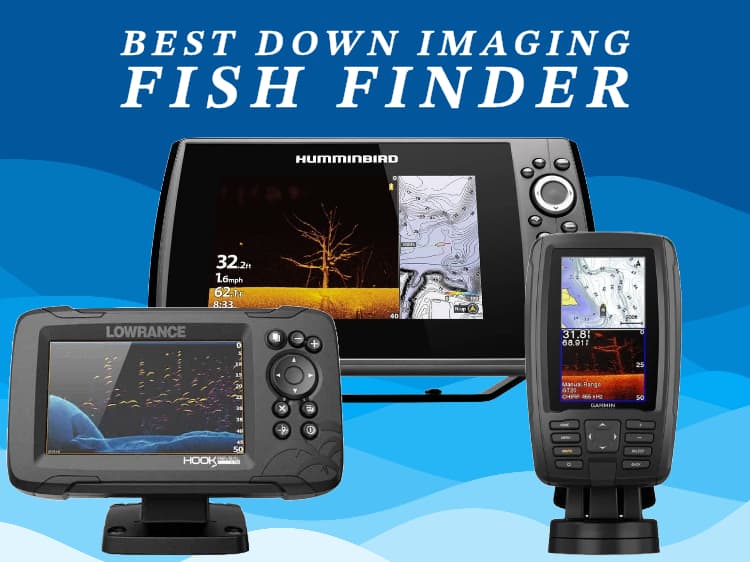Down Imaging Fish Finder uses high-frequency sonar beams to produce detailed, picture-like images of underwater structures, vegetation, and fish. Compared to traditional sonar, down imaging offers finer detail and a more intuitive display, making it easier to identify and locate fish and other underwater objects.
“Down Imaging” is the proprietary name of Humminbird and other fish finder brands use different names for this technology. Lowrance calls it “DownScan”, and Garmin calls it “ClearVu”. However, the core principle is the same: providing clear and detailed underwater views directly below the boat.
Here are the best Down Imaging fish finders in the market:
- Humminbird HELIX 8 CHIRP MEGA DI GPS G4N
- Lowrance Hook Reveal 5 Splitshot with DownScan
- Garmin Echomap Plus 44CV
- Humminbird Helix 5 CHIRP DI GPS G3
- Garmin STRIKER Vivid 7sv
- Humminbird Helix 7 MEGA Side Imaging and Down Imaging
Best Down Imaging Fish Finders 2023 – Review
1. Humminbird HELIX 8 CHIRP MEGA DI GPS G4N
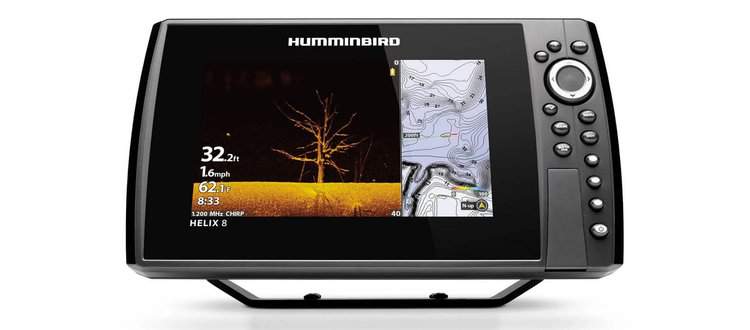
Humminbird’s HELIX 8 CHIRP MEGA DI GPS G4N is a top-of-the-line down imaging fish finder with advanced features. Here’s an overview of the features and overall performance of this unit:
- MEGA Down Imaging: One of the standout features of this model is the MEGA Down Imaging. This provides underwater clarity with coverage down to 125 feet below the boat. The MEGA Imaging technology offers unparalleled detail, revealing fish, structures, and the bottom with crystal-clear images.
- CHIRP Sonar: The CHIRP technology provides improved target separation and clarity by emitting a range of frequencies. This results in better fish identification and more detailed returns from structures and the bottom.
- Display: The HELIX 8 comes with an 8-inch color display, which provides a good screen size for viewing the detailed images produced by the MEGA Down Imaging.
- GPS and Mapping: Apart from its imaging capabilities, this unit comes with built-in GPS and mapping features, which can be beneficial for navigation and marking fishing spots.
- Ease of Use: The HELIX series is known for its user-friendly interface, making it relatively easy for both beginners and seasoned users to access its features.
- Price Range: HELIX 8 CHIRP MEGA DI, priced under $800, offers a good balance of advanced features and value. There might be other fish finders in the same price range, but the MEGA Down Imaging technology is one of the standout features of Humminbird.
- Networking: The G4N (Generation 4 Networking) provides enhanced networking capabilities, allowing users to connect multiple units, share waypoints, and integrate with other boat systems.
In summary, the down imaging features of the Humminbird HELIX 8 CHIRP MEGA DI GPS G4N are quite impressive, especially with the MEGA Down Imaging technology. It provides detailed and clear images of the underwater environment, making it a strong choice for anglers who prioritize underwater clarity and detail.
2. Lowrance Hook Reveal 5 Splitshot
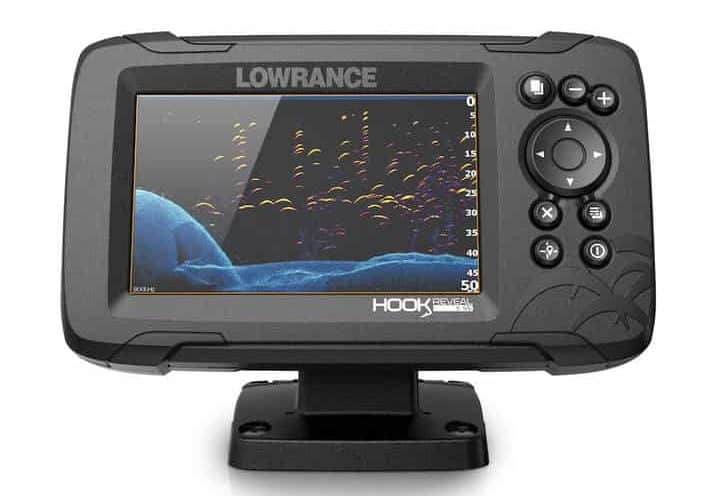
Lowrance’s Hook Reveal 5 Splitshot, priced under $400, is a more budget-friendly option compared to some of the higher-end models available. Here’s an overview of the down imaging features and overall performance of the Hook Reveal 5 Splitshot:
- SplitShot Transducer: The Hook Reveal 5 Splitshot comes with a SplitShot transducer, which provides both traditional CHIRP sonar and DownScan Imaging. DownScan Imaging is Lowrance’s version of down imaging, offering a clearer picture of the underwater environment directly below the boat.
- DownScan Imaging: The DownScan Imaging technology in the Hook Reveal series provides a clear and detailed view of underwater structures, vegetation, and fish. While it may not be as high-resolution as some of the more premium models or the MEGA Down Imaging from Humminbird, it still offers a significant improvement over traditional sonar.
- Display: The 5-inch display is relatively compact, which is to be expected in this price range. The screen provides decent clarity and detail for the images produced by DownScan Imaging.
- FishReveal: One of the unique features of the Hook Reveal series is the FishReveal technology. It combines the traditional CHIRP sonar fish arches with DownScan Imaging, making it easier to identify and locate fish.
- Ease of Use: The Hook Reveal series is designed to be user-friendly, making it suitable for both beginners and experienced users.
- Price Range: For the $400 price range, the Hook Reveal 5 Splitshot offers a decent set of features. It provides a balance of functionality and affordability, making it a good option for anglers who want down imaging capabilities without breaking the bank.
- GPS and Mapping: The unit also comes with basic GPS and mapping capabilities, which can be beneficial for navigation and marking fishing spots.
In summary, the down imaging features of the Lowrance Hook Reveal 5 Splitshot are good for its price range. While it may not offer the same level of detail or advanced features as more expensive units, it provides a clear and detailed view of the underwater environment, making it a good choice for anglers on a budget.
3. Garmin ECHOMAP Plus 43CV
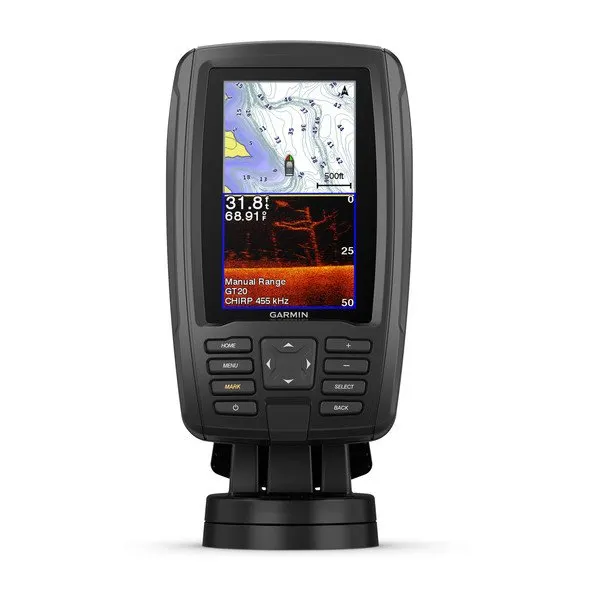
Garmin’s ECHOMAP Plus 43CV, priced under $300, is an entry-level fish finder and chartplotter combo from Garmin’s ECHOMAP series. Given its price point, it’s designed to be affordable while still offering valuable features. Here’s an overview of the down imaging features and overall performance of the Garmin ECHOMAP Plus 43CV:
- ClearVü Scanning Sonar: The ECHOMAP Plus 43CV comes equipped with Garmin’s ClearVü technology, which is their version of down imaging. ClearVü provides a nearly photographic view of what’s underneath the boat, showing underwater structures, vegetation, and fish with clarity.
- Transducer: The unit is typically bundled with a transducer that supports both CHIRP traditional sonar and CHIRP ClearVü scanning sonar. This combination provides a broad view of fish arches and detailed images of underwater structures.
- Display: With a 4.3-inch display, the screen is on the smaller side compared to other models. However, the display is clear and has a decent resolution. The compact size makes it suitable for small boats and kayaks.
- Ease of Use: The ECHOMAP series is known for its intuitive user interface. The 43CV, with its keypad interface and dedicated buttons, is straightforward to use, even for those new to fish finders.
- Price Range: For the $300 price range, the ECHOMAP Plus 43CV offers a good set of features. While it may not have the advanced capabilities of higher-end models, it provides solid down imaging capabilities for its price point, making it an excellent option for budget-conscious anglers.
- GPS and Mapping: Beyond its sonar capabilities, the 43CV also includes built-in GPS and preloaded mapping. This feature is beneficial for navigation, marking waypoints, and tracking routes.
- Quickdraw Contours: A notable feature for mapping enthusiasts is Garmin’s Quickdraw Contours, which allows users to create and store maps with 1-foot contour details.
In summary, the down imaging features of the Garmin ECHOMAP Plus 43CV are commendable for a compact unit. It provides a clear view of the underwater environment, making it a suitable choice for those looking for an affordable down imaging fish finder for small boat.
4. Humminbird Helix 5 CHIRP DI GPS G3
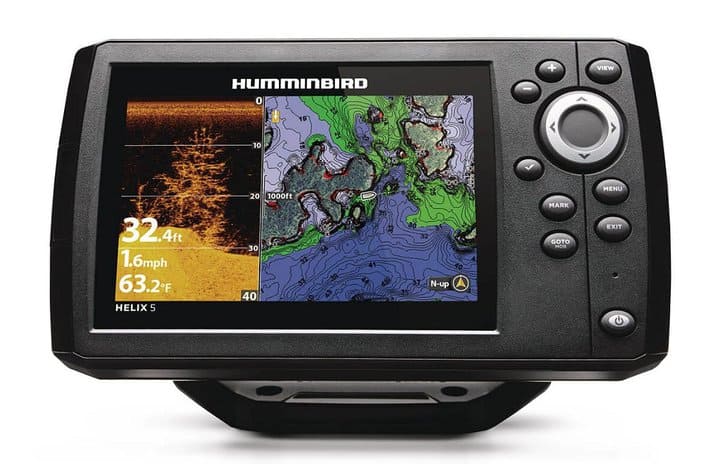
Humminbird’s Helix 5 CHIRP DI GPS G3 is part of the popular Helix series and is positioned as a budget fish finder priced under $400. Here’s an overview of the down imaging features and overall performance of the Helix 5 CHIRP DI GPS G3:
- Down Imaging (DI): The Helix 5 DI offers Down Imaging, providing anglers with a detailed and clear view of the underwater environment directly below the boat. This feature is particularly useful for identifying structures, vegetation, and fish with greater clarity compared to traditional sonar.
- CHIRP Sonar: The unit incorporates CHIRP sonar technology, which enhances target separation and reduces noise. This results in clearer images and better fish identification.
- Dual Beam Sonar: The unit offers two different sonar beam angles — a wide beam for large coverage and a narrow beam for more detailed, focused views. This dual capability allows anglers to get a broad overview of the underwater column and then zoom in on specific spots for a closer look e.g. at the fish in cover.
- Display: The Helix 5 features a 5-inch color display. The screen resolution and size are suitable for viewing detailed Down Imaging and CHIRP sonar data.
- Ease of Use: Like other models in the Helix series, the Helix 5 CHIRP DI is user-friendly with an intuitive interface. This makes it accessible for both beginners and experienced users.
- Price Range: For the $400 price range, the fish finder offers a solid set of features. Its Down Imaging capabilities are impressive for this price point, providing good value for money.
- GPS and Mapping: The unit comes with built-in GPS and mapping capabilities, allowing anglers to navigate waters, mark waypoints, and track routes.
- Memory and Expandability: The unit supports microSD cards, allowing users to save waypoints, routes, and upgrade or add maps.
In summary, the down imaging features of the Humminbird Helix 5 CHIRP DI GPS G3 are robust for its price range. The combination of Down Imaging and CHIRP sonar provides anglers with a clear and detailed view of the underwater environment. Given its price point, it offers a good balance of features and performance, making it a suitable choice for those looking for a budget fish finder with down imaging capabilities.
5. Garmin STRIKER Vivid 7sv
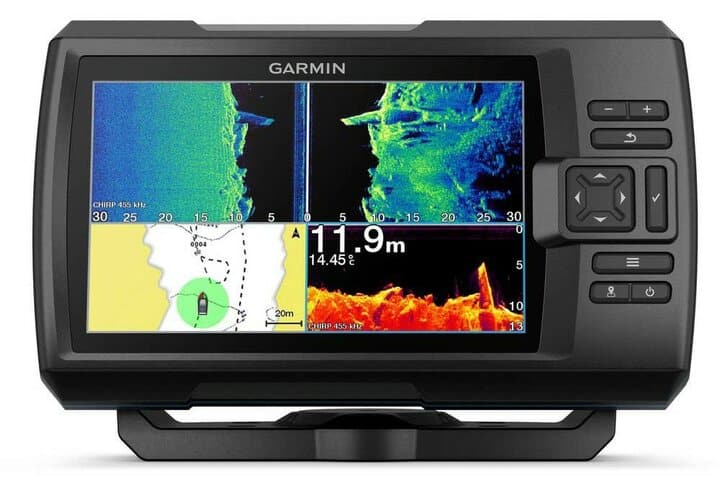
Garmin’s STRIKER Vivid 7sv, priced in the $500 range, is designed to offer a balance between affordability and performance. Here’s an overview of the down imaging features and overall performance of the Garmin STRIKER Vivid 7sv:
- ClearVu Scanning Sonar: The STRIKER Vivid 7sv is equipped with Garmin’s ClearVü technology. ClearVu provides a nearly photographic, detailed view of the underwater environment, making it easier to identify structures, vegetation, and fish beneath the boat.
- SideVu Scanning Sonar: In addition to ClearVü, the 7sv model also features SideVu (Side Imaging) scanning sonar, which offers a view of what’s on the sides of the boat. This combined capability allows for a more comprehensive understanding of the underwater environment.
- Display: The 7-inch display is one of the standout features of this model, given its price range. The “Vivid” in its name refers to the enhanced color palettes available, allowing users to choose between multiple color options for better clarity and differentiation of underwater details.
- High-Resolution Sonar: The 7sv supports both traditional CHIRP sonar and CHIRP ClearVü/SideVü scanning sonar, delivering better target separation and a clearer representation of fish and structures.
- Ease of Use: The STRIKER series is known for its user-friendly interface, and the Vivid 7sv is no exception. With dedicated buttons and an intuitive menu system, it’s relatively easy to navigate through its features.
- Price Range: For the $500 price range, the STRIKER Vivid 7sv offers a comprehensive set of features, making it a value-for-money proposition. The combination of ClearVü, SideVü, and a high-resolution display makes it one of the better options in this price category.
- GPS Capabilities: The unit doesn’t offer advanced mapping capabilities like the above mentioned models, but it does come with built-in GPS. This allows anglers to mark waypoints, navigate, and view boat speed.
- Quickdraw Contours: Like other Garmin models, the STRIKER Vivid 7sv also supports the Quickdraw Contours feature, allowing users to map and store their favorite fishing spots with detailed contour data.
In summary, the down imaging features of the Garmin STRIKER Vivid 7sv are impressive for its price range. The combination of ClearVü, a large display with vivid color options, and additional features like SideVu and GPS make it a compelling choice for anglers seeking a mid-range fish finder.
6. Humminbird HELIX 7 CHIRP MEGA SI GPS G4
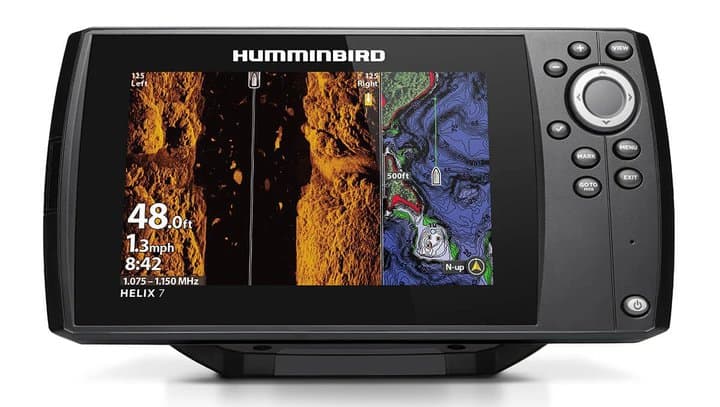
Humminbird’s HELIX 7 MEGA SI with MEGA Side Imaging and MEGA Down Imaging offers advanced sonar capabilities to anglers. Given its price point and features, it sits in the mid-to-upper range of the market. Here’s an overview of the down imaging features and overall performance of the Humminbird HELIX 7 MEGA SI G4:
- MEGA Down Imaging: MEGA Down Imaging provides underwater clarity with coverage down to 125 feet below the boat. The MEGA Imaging technology is known to produce some of the clearest and most detailed sonar images available in consumer fish finders, allowing anglers to differentiate between structures, vegetation, and fish with ease.
- MEGA Side Imaging: In addition to down imaging, the unit offers side imaging, covering up to 125 feet on either side of the boat. This broadens the view and allows for a comprehensive understanding of the underwater environment.
- Display: The HELIX 7 features a 7-inch display, which is sufficiently large to clearly view the detailed images produced by the MEGA Imaging technology. The display is sharp, colorful, and offers good sunlight readability.
- CHIRP Sonar: Apart from MEGA Imaging, the unit supports traditional CHIRP sonar, which emits a range of frequencies for better target separation and clarity. This enhances the fish-finding capabilities and provides a more rounded view of the underwater world.
- Ease of Use: The HELIX series, in general, is designed with user-friendliness in mind. The interface is intuitive, making it relatively straightforward for both beginners and experienced users to harness the full power of the device.
- Price Range: Considering it’s priced under $700, the HELIX 7 MEGA SI G4 offers a great balance of advanced features and value. The inclusion of both MEGA Down Imaging and Side Imaging in this price range makes it a competitive choice in the market.
- GPS and Mapping: This model also includes built-in GPS and mapping capabilities. The ability to mark waypoints, create routes, and use detailed lake maps further enhances its utility for anglers.
In summary, the down imaging features of the Humminbird HELIX 7 MEGA SI G4 are top-notch, especially considering its price range. The combination of MEGA Down Imaging, MEGA Side Imaging, and a host of other features positions it as one of the leading fish finders in its category.
What is Down Imaging
Down Imaging is a sonar technology used in fish finders to produce detailed, nearly photographic images of the underwater environment directly beneath a boat. It offers superior clarity compared to traditional sonar, making it easier for anglers to distinguish between fish, structure, and terrain.
Down imaging operates on the same basic principle as traditional sonar: it sends sound waves into the water, and these waves bounce back when they hit an object. The time it takes for the echo to return indicates the depth of that object.
Unlike traditional sonar, which uses a broader, conical beam, down imaging uses very high-frequency sound waves (often in the range of 455 kHz to 800 kHz or even higher in some advanced models). These high-frequency waves are emitted in a razor-thin beam straight down.
The narrowness of the beam is crucial to the technology’s success. While traditional sonar sends out sound waves in a widening cone, down imaging focuses its waves in a thin slice. This focused approach results in more detailed images since the sound waves are concentrated on a smaller area.
In down imaging, the display’s orientation is top-down. This means that the top of the screen shows the area directly under the boat, and as you move down the screen, you’re looking further behind the boat. It’s like viewing a cross-section of the water column and the bottom.
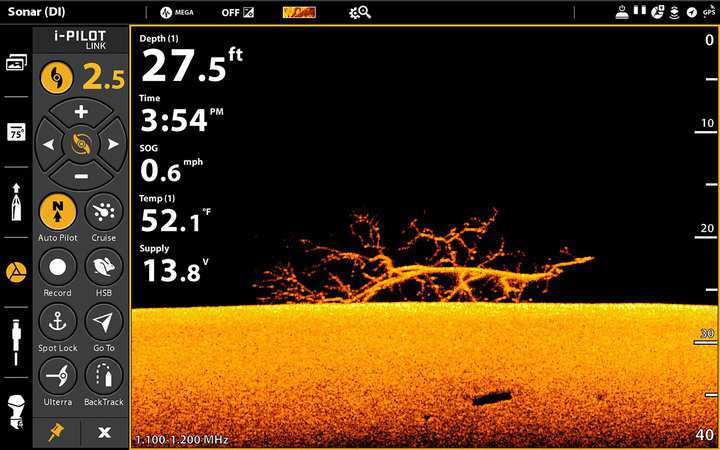
Is Down Imaging Worth It?
Whether down imaging is worth it largely depends on the specific needs and preferences of the angler, the type of fishing they engage in, and the waters they frequent. Here are some pros and cons to consider before investing in down imaging:
Pros of Down Imaging
- Detailed Views: Down imaging offers near-photographic, detailed views of the underwater environment, making it easier to differentiate between fish, structure, and vegetation.
- Clutter-Free Images: Traditional sonar can sometimes produce cluttered images, especially in deep water or areas with dense structure. Down imaging provides cleaner, clearer images with less clutter.
- Ease of Interpretation: For many users, down imaging images are more intuitive and easier to interpret than traditional sonar images, especially for those unfamiliar with reading sonar returns.
- Improved Fishing Success: The detailed images can lead to more successful fishing trips by helping anglers identify prime fishing spots and understand the underwater terrain better.
- Better for Vertical Fishing: For anglers who engage in vertical fishing techniques, like drop-shotting, down imaging provides a clearer view of what’s happening directly below the boat.
Cons of Down Imaging
- Cost: Down imaging units can be more expensive than traditional sonar units. The added cost might not be justified for casual anglers or those on a tight budget.
- Depth Limitations: In very deep waters, high-frequency down imaging may not be as effective as traditional or low-frequency sonar.
- Learning Curve: While many find down imaging more intuitive, there’s still a learning curve involved. Anglers need to spend time understanding and interpreting the images.
Factors to Consider for Investing in Down Imaging Fish Finder
- Type of Fishing: If you’re into serious fishing, especially in waters with a lot of structures, down imaging can be invaluable. Casual anglers who fish in familiar or shallow waters might not benefit as much.
- Budget: If budget constraints are significant, one might opt for a traditional sonar unit or a combination unit that offers both traditional and down imaging but might have fewer advanced features.
- Fishing Environment: In waters with a lot of structures, like submerged trees, rocks, or artificial reefs, down imaging can provide clearer views and help avoid obstacles.
- Preference and Experience: Some experienced anglers prefer the traditional sonar view and have honed their skills to interpret those images effectively. In such cases, they might not see the need for down imaging.
Down Imaging vs. Side Imaging
Down imaging and side imaging are both advanced sonar technologies used in modern fish finders to provide detailed views of the underwater environment.
Side imaging provides views of the underwater environment to the sides of the boat. It emits high-frequency sound waves in thin beams both to the left and right sides of the boat.
Side Imaging Covers a broad area on both sides of the boat, allowing anglers to scan large areas quickly. Ideal for locating structures, like submerged trees, rocks, or wrecks, and fish schools that might be away from the boat’s immediate vicinity.
Modern fish finders offer both technologies in a single unit, allowing anglers to switch between views or even display both simultaneously for a comprehensive understanding of the underwater environment.
Should you invest in a side imaging fish finder or a down imaging fish finder? It largely depends on your specific fishing needs, preferences, and the waters you frequent. Here are some factors to consider when making your decision:
1. Fishing Environment
- Large Lakes or Reservoirs: If you frequently fish in large bodies of water, side imaging can be invaluable. It allows you to scan vast areas quickly, helping you locate underwater structures, drop-offs, and schools of fish on either side of the boat.
- Rivers or Narrow Channels: In narrower bodies of water or areas with a lot of vertical structures, down imaging might be more beneficial as it provides a detailed view directly below the boat.
2. Type of Fishing
- Vertical Techniques: If you’re into vertical fishing techniques like drop-shotting or jigging, down imaging provides a clear view of what’s happening directly below, making it more suited for these techniques.
- Searching for Structures or Schools: If you’re often searching for specific underwater structures or trying to locate schools of fish, side imaging can be a game-changer. It gives a broader view and can help you find spots you might miss with only down imaging.
3. Budget
Side imaging fish finders tend to be more expensive than those with only down imaging. If budget constraints are significant, you’ll need to weigh the benefits against the added cost.
4. Learning Curve:
While down imaging is relatively straightforward for many to interpret, side imaging can have a steeper learning curve. However, once mastered, side imaging provides a wealth of information.
Conclusion
If you’re a casual angler who fishes in familiar waters or primarily uses vertical techniques, a down imaging fish finder might be sufficient. However, if you’re an avid angler looking to explore new areas, find specific structures, or locate schools of fish in varied environments, the investment in side imaging fish finder can be well worth it.

